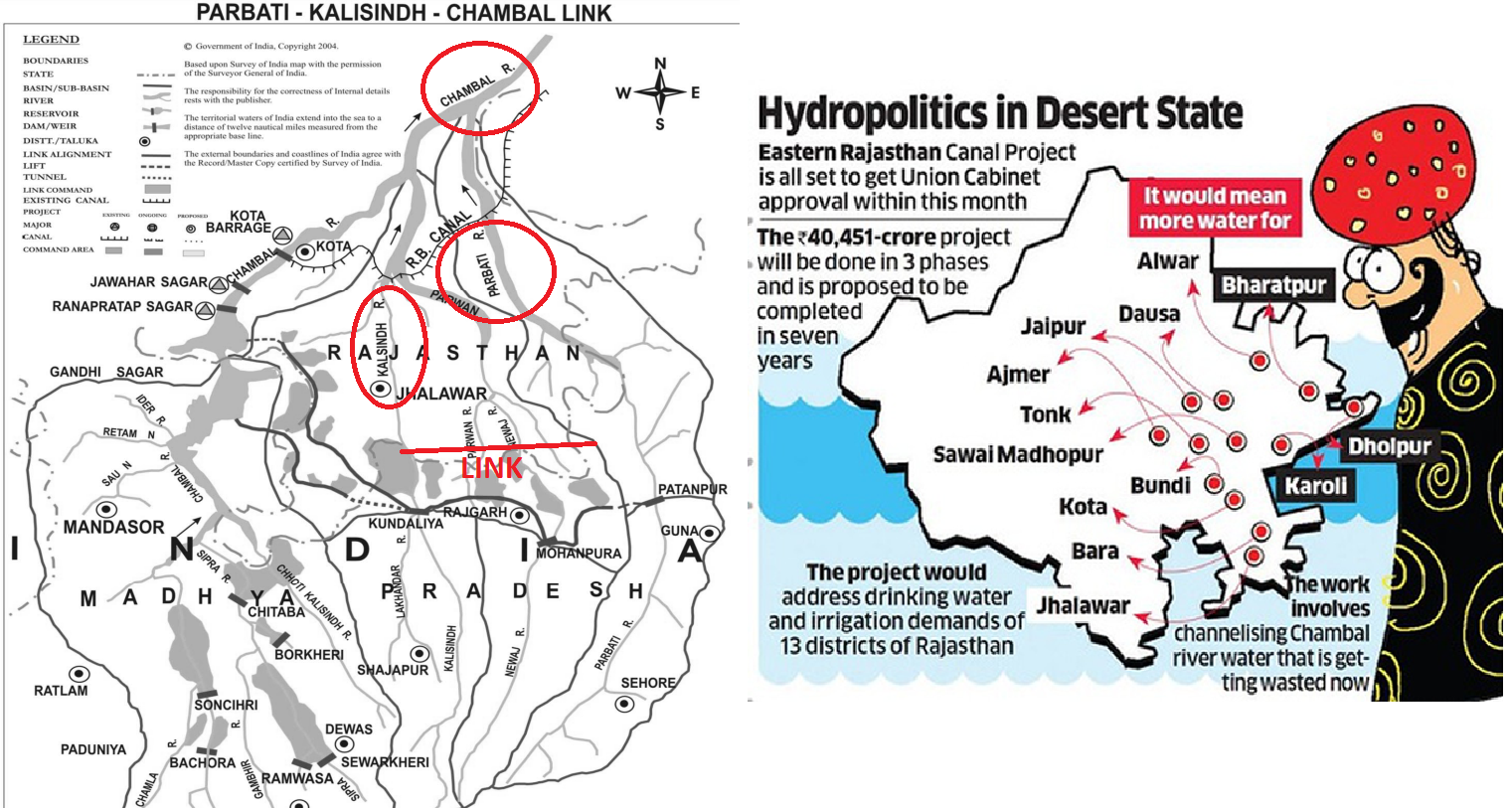Modified Parbati-Kalisindh- Chambal-ERCP (PKC-ERCP) Link Project (Indian Express)

- 29 Jan 2024
Why is it in the News?
An MoU was signed by Rajasthan and MP with the Union Ministry of Jal Shakti Sunday for implementation of the Modified Parbati-Kalisindh-Chambal-ERCP (Modified PKC-ERCP) Link Project.
What is the Modified PKC-ERCP?
- The Modified PKC-ERCP is an inter-state river linking project.
- A Memorandum of Agreement (MoA) will be finalised among Rajasthan, Madhya Pradesh, and the Centre, covering the sharing of water, exchange of water, sharing of costs and benefits, implementation mechanisms, arrangements for management and control of water in the Chambal basin, etc.
What is the PKC link project?
- The Parbati-Kalisindh-Chambal (PKC) link project is one of the 30 links included in the National Perspectives Plan formulated by the erstwhile Union Ministry of Irrigation (now Ministry of Water Resources) and the Central Water Commission in the year 1980.
- As per the National Water Development Agency (NWDA), the preliminary feasibility report of the Kalisindh-Chambal link canal project was prepared and circulated to the states concerned in September 1991.
- The report proposed the diversion of water from river Newaj (a tributary of Kalisindh) and Kalisindh to the river Chambal at either the Rana Pratap Sagar dam or the Gandhi Sagar dam.
- Rajasthan came up with the proposal of the ERCP in 2019, and to utilise water resources optimally, the Task Force for Interlinking of Rivers (TFILR) discussed its merger with the PKC link project.
- This integration was approved by the Special Committee for Interlinking of Rivers in December 2022.
What is the ERCP?
- The Eastern Rajasthan Canal Project (ERCP) is aimed at the intra-basin transfer of water within the Chambal basin, by utilising surplus monsoon water available in the Kalisindh, Parvati, Mej and Chakan subbasins and diverting it into water deficit sub-basins of Banas, Gambhiri, Banganga and Parbati.
- This will provide drinking and industrial water to 13 districts of eastern Rajasthan, namely Alwar, Bharatpur, Dholpur, Karauli, Sawai-Madhopur, Dausa, Jaipur, Ajmer, Tonk, Bundi, Kota, Baran, and Jhalawar.
What are the benefits of the modified project?
- According to the Jal Shakti Ministry, the link project proposes to provide drinking and industrial water in 13 districts of eastern Rajasthan, and Malwa and Chambal regions of Madhya Pradesh, apart from providing irrigation in 2.8 lakh ha. area (or more) each in both states (total of 5.6 lakh ha or more).
What is River Interlinking?
- River Interlinking involves the creation of artificial channels to connect rivers and water bodies, facilitating the transfer of water from regions of surplus to those facing deficits.
- Importance of River Interlinking:
- Disaster Management: River Interlinking plays a crucial role in mitigating floods and droughts, aiding in effective disaster management strategies.
- Economic Benefits: It offers economic advantages such as enhanced irrigation facilities, increased hydro-power generation capacity, and improved inland navigation, contributing to regional development.
- Ecological Restoration: River Interlinking initiatives contribute to the restoration of river ecosystems and provide support to biodiversity in water-deficient regions, fostering ecological balance.
- Concerns Associated with River Interlinking:
- Biodiversity Loss: One major concern revolves around the potential loss of biodiversity resulting from altering natural river courses and habitats.
- Community Displacement: Another significant issue is the displacement of communities residing in areas affected by river interlinking projects, highlighting social and humanitarian challenges.
About the National Perspective Plan:
- The National Perspective Plan was formulated in 1980 under the purview of the Ministry of Irrigation (currently known as the Ministry of Jal Shakti) and the Central Water Commission.
- Objective:
- The plan aims to address regional disparities by facilitating the inter-basin transfer of water resources, thereby minimizing imbalances across different regions of the country.
- Components:
- The plan consists of 30 link projects categorized into two main components:
- the Himalayan component, comprising 14 projects, and
- the Peninsular component, consisting of 16 projects.
- The plan consists of 30 link projects categorized into two main components:
